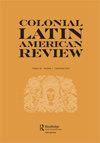Japanese objects in New Spain: nanban art and beyond
IF 0.4
2区 历史学
Q1 HISTORY
引用次数: 2
Abstract
Between the 1550s and 1650s, Japan, Portugal and Spanish America played a leading role in artistic globalization, which led to the wide circulation of Japanese objects, both in the Iberian Peninsula and in Spanish America. Between 1544 and 1571, Portuguese merchants and Jesuits established trading ports in Goa, Macau and Nagasaki, creating an intra-Asian network. In 1565, the Spanish settlement in Cebu, as well as the discovery of the return route across the Pacific, coincided with the fact that the Ming dynasty loosened its ban on maritime trade in 1567, allowing Chinese merchants to engage in commercial activity. The Spanish trade route between Manila and Acapulco was launched in 1573. Once the port of Nagasaki was open to trade exchange with Portugal in 1571, ‘The Portuguese became essential agents in the trade between China, Japan, and India, on one hand, and the Philippines, on the other’ (GaschTomás 2019, 58). In turn, material evidence and documents testify to the circulation, consumption, and adaptation of Asian commodities in the Americas, whose role in these processes has long been underestimated. Dobado (2014) and Gasch-Tomás (2019) are among the recent scholars who have demonstrated New Spain’s central position in the making of connections between the Spanish Empire and Asia during the late sixteenth to early seventeenth centuries. This led to the ‘greater commoditisation of Asian goods in the viceroyalty of New Spain than in Castile’ from 1580 to 1630 (Gasch-Tomás 2019, 42). But even into the eighteenth century, a large number of Japanese porcelain pieces circulated in New Spain, proof that Japanese-Spanish American artistic relations were complex throughout the colonial period. In 1614, the shogunate banned Christianity and expelled Catholics from Japan, closing itself off in 1639, yet leaving some ports open to international trade. Under these conditions, how did Japanese goods continue to circulate in the Americas after 1640? They must have been transported by Manila-Acapulco galleons. But since neither the Portuguese nor the Spanish could land in Japanese territories, it is possible to propose different routes: 1) the Dutch transported commodities to Batavia, and then Chinese merchants took them to Manila; 2) Chinese traders carried Japanese goods from新西班牙的日本物件:南班艺术及其超越
1550年代至1650年代,日本、葡萄牙和西班牙美洲在艺术全球化中发挥了主导作用,这导致了日本物品在伊比利亚半岛和西班牙美洲的广泛流通。1544年至1571年间,葡萄牙商人和耶稣会士在果阿、澳门和长崎建立了贸易港口,建立了亚洲内部网络。1565年,西班牙人在宿务定居,并发现了穿越太平洋的返回路线,与此同时,明朝于1567年放松了对海上贸易的禁令,允许中国商人从事商业活动。西班牙在马尼拉和阿卡普尔科之间的贸易路线于1573年开通。1571年,长崎港对葡萄牙开放贸易交换后,“葡萄牙人成为中国、日本和印度与菲律宾之间贸易的重要代理人”(GaschTomás 2019,58)。反过来,物证和文件证明了亚洲商品在美洲的流通、消费和适应,而这些商品在这些过程中的作用长期以来一直被低估。Dobado(2014)和Gasch Tomás(2019)是最近的学者之一,他们证明了新西班牙在16世纪末至17世纪初西班牙帝国与亚洲之间建立联系方面的核心地位。这导致1580年至1630年,“新西班牙总督府的亚洲商品化程度高于卡斯蒂利亚”(Gasch Tomás 2019,42)。但即使到了18世纪,大量的日本瓷器在新西班牙流通,这证明了在整个殖民时期,日美艺术关系是复杂的。1614年,幕府禁止基督教,并将天主教徒驱逐出日本,于1639年关闭,但仍保留一些港口对国际贸易开放。在这种情况下,1640年以后,日本商品是如何在美洲继续流通的?它们一定是由马尼拉-阿卡普尔科大帆船运送的。但由于葡萄牙人和西班牙人都无法在日本领土上登陆,因此有可能提出不同的路线:1)荷兰人将商品运到巴达维亚,然后中国商人将商品带到马尼拉;2) 中国贸易商从
本文章由计算机程序翻译,如有差异,请以英文原文为准。
求助全文
约1分钟内获得全文
求助全文
来源期刊

Colonial Latin American Review
HISTORY-
CiteScore
0.60
自引率
25.00%
发文量
25
期刊介绍:
Colonial Latin American Review (CLAR) is a unique interdisciplinary journal devoted to the study of the colonial period in Latin America. The journal was created in 1992, in response to the growing scholarly interest in colonial themes related to the Quincentenary. CLAR offers a critical forum where scholars can exchange ideas, revise traditional areas of inquiry and chart new directions of research. With the conviction that this dialogue will enrich the emerging field of Latin American colonial studies, CLAR offers a variety of scholarly approaches and formats, including articles, debates, review-essays and book reviews.
 求助内容:
求助内容: 应助结果提醒方式:
应助结果提醒方式:


